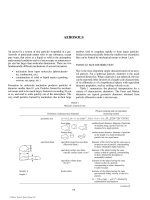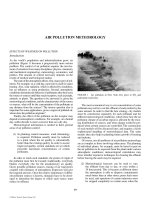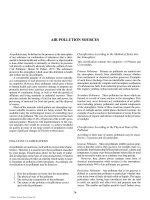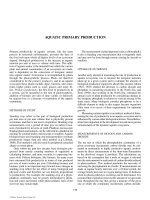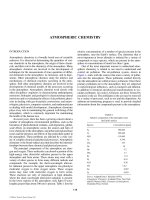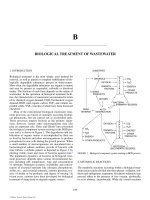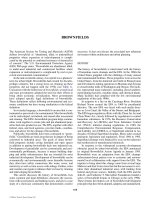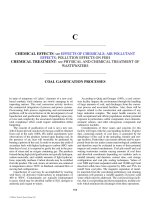ENCYCLOPEDIA OF ENVIRONMENTAL SCIENCE AND ENGINEERING - BROWNFIELDS pot
Bạn đang xem bản rút gọn của tài liệu. Xem và tải ngay bản đầy đủ của tài liệu tại đây (221.67 KB, 6 trang )
160
BROWNFIELDS
The American Society for Testing and Materials (ASTM)
defines brownfields as “abandoned, idled, or underutilized
properties where expansion or redevelopment is compli-
cated by the potential or confirmed existence of chemical(s)
of concern.” The U.S. Environmental Protection Agency
(EPA) Web page states, “Brownfields are abandoned, idled,
or under-used industrial and commercial facilities where
expansion or redevelopment is complicated by real or per-
ceived environmental contamination.”
In the mid-twentieth century, brownfield was a planners’
term for urban blight. Brownfields had existed for decades,
perhaps centuries, but a strong focus on cleaning up these
properties did not happen until the 1970s (see Table 1).
Concurrent with the federal use of brownfields, several local
and state governments adopted the term for their efforts to
bring about economic revitalization. Most governments
have adopted specific legal definitions of brownfields.
These definitions reflect differing environmental and eco-
nomic conditions but have strong similarities to the federal
definition.
In everyday language, a brownfield is an area that is con-
taminated or perceived to be contaminated. Most brownfields
can be redeveloped, revitalized, and reused after assessment
and cleanup. The EPA’s brownfields program helps commu-
nities work together to create jobs and put abandoned prop-
erties back into productive use. The EPA, together with other
federal, state, and local agencies, provides funds, coordina-
tion, and advice for the cleanup of brownfields.
Politically, brownfields have been contrasted to “green-
fields.” Greenfields are rural areas that are in danger of being
converted to industrial areas. The goals of many brown-
field programs include saving farmland and open spaces
in addition to putting brownfields back into industrial use.
Development of greenfields can be economically and envi-
ronmentally problematic, because it means building ship-
ping and utility infrastructures that are essential for most
industrial development. Development of brownfields can be
economically and environmentally more desirable because
they often have utility connections like water, sewer, and
electricity as well as train access with sidings. Further, cities
and counties can regain or enhance their tax base by cleaning
and redeveloping brownfields.
This article discusses the history of brownfields, lists
some common and legal definitions, discusses the associa-
tions with social justice and banking issues, and gives a case
study of a showcase community that demonstrates creative
successes. It does not discuss the associated new urbanism
movement within architecture and urban planning.
HISTORY
The history of brownfields is intertwined with the history
of hazardous-waste cleanups and the EPA. In the 1960s the
United States grappled with the challenge of many unused
and contaminated facilities. These properties were across the
United States, from the shuttered steel mills in Pennsylvania
and Cleveland to mining operations in Montana and Arizona
to closed timber mills in Washington and Oregon. The facili-
ties represented many industries, including closed smelters,
metal-plating factories, machine shops, and chemical plants.
Many facilities had complied with the few environmental
regulations of the early 1900s.
In response to a fire on the Cuyahoga River, President
Richard Nixon created the EPA in 1969 by presidential
directive. The new EPA was faced with such media disas-
ters as Love Canal, the Valley of the Drums, and Bridgeport.
The EPA began regulatory efforts with the Clean Air Act and
Clean Water Act, closely followed by regulations to control
hazardous substances. In 1976, the Resource Conservation
and Recovery Act (RCRA) and Toxic Substance Control
Act (TSCA) initiated cleanup regulations. In 1980, the
Comprehensive Environmental Response, Compensation,
and Liability Act (CERCLA, or Superfund) ushered in two
decades of federal Superfund cleanups. Many states created
analogous legislation and regulations. From 1984 to 1995,
Superfund cleanups were financed by a tax on the industries
that synthesized or manufactured chemicals.
In response to the widespread economic-development
obstacles posed by urban brownfields, the EPA announced
its original Brownfields Action Agenda in January 1995.
Brownfields were an adaptation from the EPA cleanup-
enforcement-driven pattern over to economic and environ-
mental local collaboration with support from the EPA. The
impetus to bring about this change came from several large
Midwest and East Coast cities that led the movement to revi-
talize their abandoned industrial areas with funding from
federal and private sources. Initially, both the EPA and the
John D. and Catherine T. MacArthur Foundations funded a
series of brownfield forums in Chicago in the early 1990s.
These forums developed a set of brownfield redevelopment
principles that have been adopted, adapted, and standardized.
© 2006 by Taylor & Francis Group, LLC
BROWNFIELDS 161
TABLE 1
Brownfields time line
Brownfields Timeline 1976 77 78 79 80 81 82 83 84 85 86 87 88 89 90 91 92 93 94 95 96 97 98 99 2000 01 02 03
Resources Conservation & Recovery Act
(RCRA)—1976, 1984
Toxic Substance Control Act (TSCA)—
1976
Waste-treatment facility fire, Bridgeport,
New Jersey—1977
Children hurt at waste dump, Love Canal,
New York—1978
Discovery of Valley of the Drums site,
Kentucky—1979
Comprehensive Environmental Response,
Compensation, & Liability Act
(CERCLA or Superfund)—1980
$1.6 billion tax-funded trust fund
authorized—1980
Environmental Justice Movement, Warren
County, North Carolina—1982
Superfund Amendments & Reauthorization
Act (SARA)—1986
Superfund trust fund increased to $8.5
billion—1986
Brownfields Initiatives announced—1993
Small Business Liability Relief and
Brownfields Revitalization Act—1993
EPA Brownfield Action Agenda—1995
CERCLA/SARA tax on chemical &
petroleum industry sunsetted—1995
Brownfield National Partnership—1997
Superfund Redevelopment Initiative—1999
Brownfield Initiative/Harvard’s Innovation
in Government Award—2000
Expanded Brownfield Cleanup Revolving
Loan Fund—2000
Relaim Pennysylvannia—cleanup of
mining grayfields—2002
Nationwide movement to clean up
abandoned grayfields—2003
© 2006 by Taylor & Francis Group, LLC
162 BROWNFIELDS
Some of these principles have become engineering practice
in the “Standard for Process of Sustainable Brownfields
Redevelopment” from the ASTM.
In association with the forums, the Chicago Brownfield
Initiative began with a pilot cleanup and redevelopment pro-
gram in 1993. The Chicago Department of Environmental
Protection, in partnership with the mayor’s office and
the Chicago Departments of Planning and Development,
Buildings, and Law, coordinated the brownfields pilot pro-
gram. The pilot program involved the cleanup up of five
abandoned polluted industrial sites and initiated redevelop-
ment. The five pilots resulted in new construction activity
and the creation of jobs. The city’s experience with these
sites became a national model for continued innovation at
large-scale cleanups.
Chicago shared its experiences by hosting another
brownfield forum to discuss the legal, financial, and ethi-
cal issues related to urban disinvestments. The forum, which
included business leaders, industrialists, environmentalists,
bankers, regulators, and city officials, generated a list of rec-
ommended actions to facilitate brownfield cleanups and rede-
velopments. Cities across the United States began to use the
successful Chicago-recommended actions. Chicago revisited
its forum recommendation in late 1997 to assess local and
national progress. This conference increased national atten-
tion and validated the work since the first conference. More
urban areas took the model and made it theirs.
One city that took the model and made it theirs is St. Louis,
Missouri. St. Louis, like many older cities, had deteriorated
commercial districts that imposed a blighting effect on sur-
rounding residential neighborhoods. St. Louis began one of
the earliest brownfields programs in the mid-1990s. By 2000,
St. Louis had cleaned up many sites using the brownfields
approach. Mayor Freeman Bosley detailed the experiences
at several sites in congressional testimony. In one targeted
area, the city paid to assemble, clear, and clean a corner site
critical to the shopping district’s viability. According to the
mayor, the owners of this area had not been able to command
sufficient rent to maintain their property. When cleanup was
accomplished, a private company invested in what is now a
thriving commercial business district that provides employ-
ment, generates sales, and helps to attract patrons to other
retail and eating establishments in the area.
On May 13, 1997, Vice President Al Gore announced the
Brownfields National Partnership Action Agenda (National
Partnership), outlining the EPA’s activities and future plans to
help states and communities implement and realize the ben-
efits of the brownfields initiative. The National Partnership
brings together federal agencies to address brownfield clean-
ups and redevelopments in a more coordinated approach.
AGENCIES, CITIES, AND UNIVERSITIES INVOLVED
IN BROWNFIELDS
The other seven federal agencies involved are: the
Department of Housing and Urban Development (HUD),
the Department of Transportation (DOT), the General Services
Administration (GSA), the National Oceanic and Atmospheric
Administration (NOAA), the Department of Health and
Human Services (DHHS), the Department of Labor (DOL),
and the Department of Energy (DOE). HUD administers the
Brownfields Economic Development Initiative (BEDI) as
the key competitive grant program to stimulate and promote
economic- and community-development activities under
Section 108(q) of the Housing and Community Development
Act of 1974. Through BEDI, HUD administers these grants
to stimulate local governments and private-sector parties
to redevelop or continue phased redevelopment efforts on
brownfield sites where environmental conditions are known
and redevelopment plans exist. The DOT has multiple
approaches to support transportation-related brownfields by
funding cleanups as part of its infrastructure development,
work with other agencies on brownfields for transportation-
related uses, encourage consideration of transportation access
in redevelopment planning, and identify policies that dis-
courage transportation-related brownfields redevelopment.
With thousands of federal properties located throughout the
country, the GSA is partnering with communities to ensure
that underutilized federal properties are an active component
in the redevelopment of our nation’s urban centers. NOAA
has a signed agreement with the EPA to lay the groundwork
for revitalizing aging port-city waterfronts. The DHHS spec-
ifies essential services to be provided by its health-related
agencies and the larger public-health community that must
be applied to each brownfields project to assure public-health
protection. The DOL, through its Office of Environmental
Management, Office of Intergovernmental and Public
Accountability, has developed an electronic access (Internet-
based) system to provide technical assistance and increase
community members’ capacity to understand and resolve
environmental issues related to brownfields. The DOE
provides technical assistance in brownfield efforts from its
Headquarters Program Offices and the National Laboratories
and Technology Centers.
Many major urban areas, through both cities and coun-
ties, have associated with the federal brownfields, and some
have continued their own brownfields efforts. Pittsburgh,
Pennsylvania, is a city that develops brownfields innovations
in association with Carnegie Mellon University while it contin-
ues to work with the EPA. Another city with a strong university
affiliation is Cincinnati, Ohio, where collaboration with the
University of Cincinnati provides training and environmental-
justice support and broadens community affiliations.
COMMON AND LEGAL DEFINITIONS
The EPA and other environmental- and health-protection agen-
cies base their regulations and implementation on science. Most
often they adapt technical definitions that are measurable and
science-based into regulations. The terms surrounding brown-
fields do not follow this pattern. Brownfields definitions bring
a community-based sensibility. The complexity and plasticity
© 2006 by Taylor & Francis Group, LLC
BROWNFIELDS 163
of brownfields begins in the definitions and continues through
implementation.
Legally, the EPA uses the definition of brownfield
in Public Law 107-118 (HR 28869), the Small Business
Liability Relief and Brownfields Revitalization Act, signed
into law January 11, 2002. This definition says that “within
certain legal exclusions, the term ‘brownfield site’ means
real property, the expansion, redevelopment, or reuse of
which may be complicated by the presence or potential pres-
ence of a hazardous substance, pollutant, or contaminant.”
Following the definition are pages of exclusions that pri-
marily detail sections of other laws with priority. The pri-
mary statutory authorities citied are: the Clean Water Act,
as amended in 1977; CERCLA of 1980, commonly called
Superfund; the RCRA, as amended in 1984; the Superfund
Amendments and Reauthorization Act (SARA) of 1986;
the Medical Waste Tracking Act of 1988; the Great Lake
Critical Programs Act of 1990; the Clean Air Act of 1990; the
Clean Water Act of 1990; and the Housing and Community
Development Act of 1992.
On many publications and Web pages on brownfields,
the EPA discusses them as “abandoned, idled or under-
used industrial and commercial facilities where expansion
or redevelopment is complicated by real or perceived envi-
ronmental contamination.” This definition facilitates the
EPA’s Brownfields Economic Redevelopment Initiative in
empowering states, communities, and other stakeholders
involved in brownfield revitalization to work together on
redevelopment.
The definitions of brownfields by states are varied, as are
the patterns of implementation. They vary from Missouri,
with one of the oldest and most defined brownfields pro-
grams; to Washington, with an operating program without a
definition; to Alaska, with no definition or program.
Missouri’s complex definition of brownfields comes
from its 1995 brownfields legislation in Chapter 447 of
the Revised Statutes of Missouri (commonly known as
the Brownfields Redevelopment Program). The Missouri
Department of Natural Resources (MDNR) and the Missouri
Department of Economic Development jointly have the fol-
lowing definition. To be a brownfield in Missouri, a project
must meet two criteria:
1. All projects must enter and be accepted into the MDNR
Voluntary Cleanup Program which provides property
owners with oversight of and concurrence with all cleanup
activities.
2. A project will be considered eligible if it meets the fol-
lowing criteria:
(a) The property
must have been abandoned for at least
three years or underutilized. Real property is under-
utilized if less than 35% of its commercially usable
space is used for its most commercially profitable and
economically productive use.
(b) The property is owned by a local, state, or federal gov-
ernmental agency, or by a private party who is to the
potential responsible party, and the project is endorsed
by the local municipality;
(c) The property is contaminated, or perceived to be con-
taminated, by a hazardous substance; and,
(d) The property is planned to undergo redevelopment
for a commercial, mixed-use, or industrial use that
is expected to create at least 10 jobs or retain at least
25 jobs, or some combination thereof.
The state of Washington discusses brownfields as “the short-
hand term for historically contaminated and underutilized or
vacant industrial property” on its Web page. In some litera-
ture it defines brownfields as “properties that are abandoned
or underused because of environmental contamination for
past industrial or commercial practices.” However, there is
not a definition in any state statute or regulation. If the public
thinks a site is a brownfield—it is. Nevertheless, Washington
maintains an active brownfields program, with a showcase
project in Seattle and King County as its model. That project
is discussed in the case study below.
ASSOCIATED ISSUES: ENVIRONMENTAL JUSTICE
AND BANKING
Many contaminated properties are located in areas such as
older urban centers, where a high proportion of the residents are
minorities, have low incomes, or do not have English as their
first language. These common problems reflect the economic
limitations faced by disadvantaged individuals. Therefore, dis-
advantaged communities must overcome special barriers to
effectively advocate for their community interests during the
review and permitting of projects with potential environmental
impacts. This created environmental injustice. In 1982, Warren
County was the poster child for environmental injustice and
documented racism. That year, citizens banded together and
made the Warren County PCB landfill protest a seminal event
for the environmental-justice movement. The North Carolina
Environmental Justice Network (NCEJN) was formed, and it
became a catalyst that galvanized people of color in the fight
for environmental justice. The struggle in Warren County was
the spark that lit that national environmental-justice movement
in the 1980s.
In its most basic interpretation, environmental justice
(EJ) is the principle that all people have the right to be pro-
tected from environmental pollution and to receive a fair
share of environmental benefits. It combines environmen-
tal protection with considerations of nondiscrimination and
civil rights. Many organizations have been formed on the
model of the NCEJN to support these principles locally.
Additionally, governments have provided support through
agencies such as the Oregon Governors Environmental
Justice Advisory Board.
EJ policies seek to level the playing field by providing
disadvantaged communities with technical and organiza-
tional support, by providing special scrutiny for proposed
projects in EJ communities that might result in significant
© 2006 by Taylor & Francis Group, LLC
164 BROWNFIELDS
environmental impact, and by offering incentives for certain
desirable types of development, including brownfields. EJ
policies go beyond brownfields. However, brownfields are
an effective means for advancing EJ principles.
When HUD administers brownfields grants, it has EJ
requirements. HUD works with community organizations,
the private sector, local and state governments, and other
federal agencies to provide equitable reinvestment in com-
munities with fair employment opportunities. Other agen-
cies, such as the Agency for Toxic Substance and Disease
Registry’s Office of Urban Affairs, are actively involved in
issues such as public-health issues that are linked to EJ.
Bankers make lending decisions that affect brown-
fields. Initially, bankers chose to lend on greenfields, rather
than brownfields, because brownfields bring unpredictable
expense and liability—this despite the fact that greenfields
may be more expensive because of the infrastructure that
needs to be built. The unpredictable expense and liability
of brownfields came from the wide variability in cleanup
and associated legal costs. Without some predictability
for cleanup and liability costs, banks were biased toward
the more predictable greenfields without infrastructures,
like rail connections, sewer, water, electricity, and nearby
communities to provide. The EPA’s brownfield program
brought predictability through its multiagency collabora-
tive approach. This approach, combined with funding, often
overcame the reluctance of bankers to fund the develop-
ment of brownfields. Additionally, bankers rely on techni-
cal standards developed by other fields to make decisions.
With the engineering standards that have been developed in
the 1990s such as the “Standard for Process of Sustainable
Brownfields Redevelopment” from the ASTM, banks have
reliable technical standards. Finally, banks are members of
the community and are positively influenced by brownfields
because of the community support and process.
From the success of the brownfield cleanups, an associated
movement to clean up grayfields has developed. “Grayfields”
are defined as blighted or obsolete buildings sitting on land
that is not necessarily contaminated. Grayfields range from
aging shopping malls in the suburbs to mining reclamation
across the Pennsylvania countryside. Many regions hope to
have grayfield successes using some of the partnerships and
methods developed by brownfield programs.
SEATTLE AND KING COUNTY CASE STUDY
Case studies are written discussions of a topic containing an
applied example of the topic. Case studies are used in legal,
business, and environmental studies. There are many case
studies to select from, because from 1993 to 2000, the EPA
has provided over $250 million in brownfields funding in the
form of grants and loans. More that 50 brownfield-related
job-training and redevelopment demonstration projects have
been funded. Projects have ranged from innovative test pilots
for heavily contaminated areas in large cities to small com-
munities with a large brownfields.
The case study below discusses a brownfield showcase
community initiative in Seattle, Washington, that uses dif-
fering levels of technology and different levels of private–
public cooperation at several sites. The Seattle and King
County Brownfields Initiative was one of the 11 initially
funded under the EPA Brownfields Showcase Communities
Initiative. The funding comes through the King County and
Seattle Offices of Economic Development and has been
renewed because of a track record of successes.
This initiative has two tracks. First, several small busi-
nesses have received assistance from the brownfields pro-
gram that has enabled them to return contaminated industrial
properties to productive businesses. Second, area-wide proj-
ects have made cleanups more attainable for all businesses
under their umbrellas.
One of the businesses receiving funding was an auto-
wrecking yard, All City Wrecking, that has been cleaned up
and redeveloped as a neighborhood store and gas station. This
2-acre site supported a family-owned auto wrecking yard for
30 years. As the owners neared retirement, they ceased oper-
ating their business with the hopes of selling their property.
The presence of contamination posed challenges to that sale.
The site was contaminated with oil, petroleum products, and
heavy metals. The Environmental Extension Service (EES),
a contractor under the grant, was able to help this business
overcome the difficulties of addressing the contamination.
The EES provided free assistance at every stage of the
project. The EES helped the owners properly dispose of
liquid wastes on the site, and obtained a local matching grant
to defray disposal costs. The EES then assisted in selecting
and hiring consultants to perform both the assessment and
cleanup on the property, reviewed and interpreted consultant
reports for the owners, and made recommendations for how
to proceed with assessment and cleanup. Within approxi-
mately 8 months, the All City Wrecking site underwent
environmental testing, cleanup, and compliance monitoring.
This process ended with a “No Further Action” designation
by the Washington Department of Ecology and has enabled
this property to be sold, redeveloped, and recycled for a
new productive use as a neighborhood store and gas station.
There were many such cleanups that were facilitated by the
umbrella projects described below.
Two wide-ranging projects facilitated the cleanup of
all properties in their respective ranges. The largest,
Washington’s newly established risk-based cleanup stan-
dards for total petroleum hydrocarbons (TPH), was state-
wide. The other project was the localized Duwamish
Corridor Groundwater Study. This study characterized the
groundwater in a heavily industrial area that has been cre-
ated with material dredged from the river and washed from
the hills and documented that the groundwater was not a
drinking-water aquifer. Both of these government efforts
had the effect of streamlining projects and reducing the
cleanup costs. The more flexible TPH cleanup standards
enabled this project to clean the soil up to a commercial,
rather than a residential, cleanup level. The groundwater
study, funded by King County from state and federal grants,
© 2006 by Taylor & Francis Group, LLC
BROWNFIELDS 165
helped to streamline the evaluation and regulatory process
for each site. Both reduced the time needed to collect back-
ground information on sites, thereby lowering the costs of
site evaluation.
This and other brownfield cleanups in Seattle and King
County were facilitated by:
1. A 5-year project to improve the science for char-
acterizing and guiding the cleanup of petroleum-
contaminated sites statewide. The changes to state
law recommended by this project were ecological
as part of the revisions to Washington’s Model
Toxics Control Act Regulation.
2. An interagency project that provided the
Duwamish Corridor Groundwater Study of an
industrial area by a river that is important to ship-
ping. The area included parts of south Seattle and
adjacent King County.
3. The creation of a technical-assistance center
(the EES) run by the nonprofit Environmental
Coalition of South Seattle (ECOSS), which pro-
vides direct, door-to-door assistance to manufac-
turing and industrial businesses in environmental
cleanup and pollution-prevention practices.
4. A revolving loan fund for environmental cleanup
for which a partnership among King County, the
city of Seattle, the city of Tacoma, and the state of
Washington manage the EPA grant money.
CONCLUSION
Brownfield programs are a highly successful phase of envi-
ronmental cleanups in the United States. The first phase was
science-based and regulation-driven cleanups. That phase
began in 1976 and continues to this day. Occasionally, these
cleanups involve economically viable properties that go
right back into use. More often, the cleaned-up sites involve
abandoned, idled, or underutilized properties. In those cases,
the expansion or redevelopment is complicated because of
the potential or confirmed contamination. Therefore, the
brownfield approach was added in 1993 as a phase that
ideally works with the cleanup and then continues through
redevelopment. The two approaches continued concurrently.
When the federal tax to fund Superfund cleanups was sun-
setted in 1995, the number of cleanups began to decline. As
Superfund monies run out, brownfield funding will become
more important. Brownfield programs coordinate agency and
private-sector interests to work together to create jobs and
put abandoned properties back into productive use. Problems
may arise when the brownfield cleanups are underfunded,
the local economy is weak, or cooperation is not achieved.
Despite these obstacles, brownfield pilots and projects
have been documenting success stories for over a decade.
Brownfields have sparked social economic movements such
as EJ and economic revitalization of grayfields.
The next phase of environmental cleanups has not yet
arrived. Currently, brownfield programs are active across the
United States. Their goal is to have all contaminated sites
cleaned cooperatively and put back into use. If cleanup and
brownfield sites remain clean and no further sites are cre-
ated, cleanup programs may work themselves into obso-
lescence. Related movements like EJ and grayfields begun
from brownfields will separate as their goals differ. However,
brownfields are likely to remain at a smaller and increasingly
more sophisticated level for decades.
REFERENCES
ASTM, Standard for Process of Sustainable Brownfields Redevelopment,
E-1984–98, November 10 (1998), published January 1999.
/>tentType=GSA_OVERVIEW
/>index.cfm
/>index.cfm
International City/County Management Association, Brownfields Blue-
prints, A Study of the Showcase Communities Initiative, 2000.
United States Environmental Protection Agency, Brownfields, Office of
Solid Waste and Emergency Response (5102G), EPA 542-B-97-002.
LEE DORIGAN
King County Department of Natural Resources
© 2006 by Taylor & Francis Group, LLC

